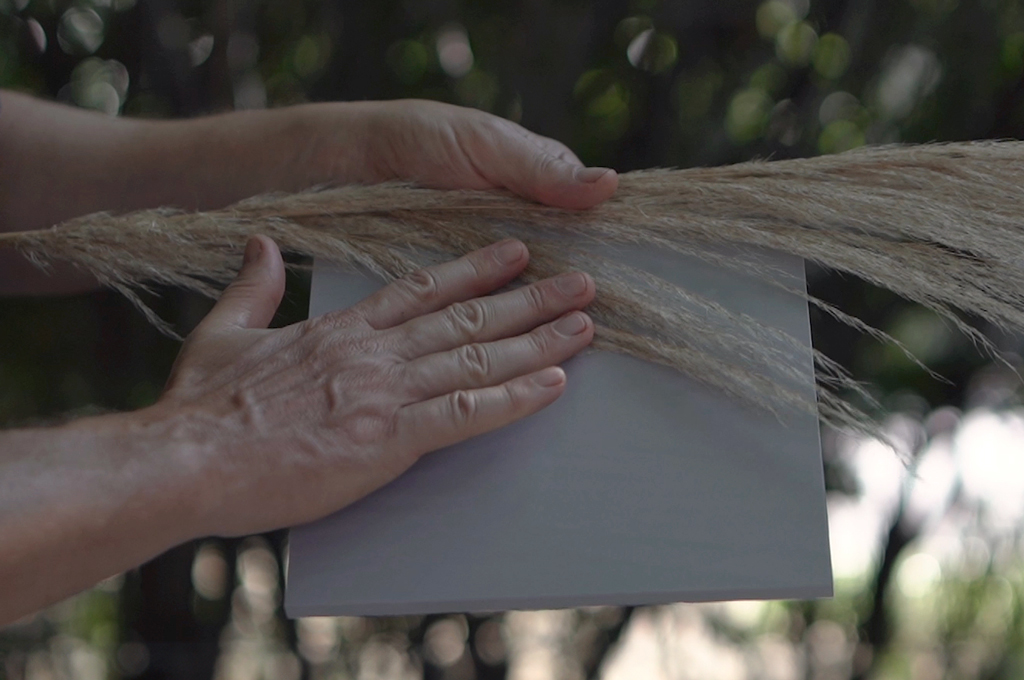To expand knowledge, architect Marko Brajovic counted on the partnership of biologist and biomimicry, Alessandra Araújo, founder of bio-inspirations and innovation designer in corporate segments, who carried out research on the complexities existing in Brazilian diversity.
The study covered topics such as: well-being, health, cities, geology and feelings, with results that attempt to understand human interactions with “the skins of Brazil”, a term used to refer to biomes. To better understand the creative development of the collection, we interviewed the biologist, who explains the behind-the-scenes behind the products.
1 – What is biomimicry?
Products: Amb Pampas Aurora Nat 90x90cm 55.4×55.4cm 21x21cm 13.3x21cm | Amb Pampas Mate and Capim NAT 90x90cm | Photo: @tardelliwork | Production: Debbie Apsan
AA: Biomimicry is a science and a practice. As a science, it studies the strategies and mechanisms of how nature and all its organisms have managed to survive and reproduce for 3.8 billion years. As a practice, it is a practice of innovation, which traces in greater depth the relationship between the problem to be solved and the answers that can be found in nature. Biomimetics seeks to understand how this interaction is established, is inspired by this organism, and from there, applies this principle to the design to be developed. Therefore, biomimicry is an innovation not just of form for form’s sake. It’s not a roof in the shape of a leaf, for example, but rather, understanding the leaf as a strategy, as a function.
2 – How important is biomimicry for the context of cities and living?
AA: The importance of biomimicry for contemporary life is fundamental in all aspects of sustainability and regeneration, because biomimicry is related to the principles of how life creates conditions conducive to continuing life, which governs life’s ability to thrive. keep it alive and generate more. Everything that is created or built through biomimicry are processes and products that have the continuity of life as their concept, that is, they will not generate dangerous waste, they will not generate products that have a short useful life, that require a lot of energy or that damage the environment. environment.
Products: Amb Caatinga Ferro, Cumaru and Xique Xique NAT 90x90cm 55.4×55.4cm 34.4×34.4cm 21x21cm 13.3x21cm | Photo: @tardelliwork | Production: Debbie Apsan
For the urban context and for health reasons, what cities need is to regenerate spaces, because metropolises grow quickly and at a very high speed, consequently being large polluting chains to create and maintain their built spaces. So, having biomimicry as a principle means going beyond the basic sustainability criteria or any existing legislation.
3 -What was the research process like for developing the Biomas collection?
AA: The research and inspiration process for creating the Biomas collection was super interesting. We don’t start by looking at trends or urban needs. We went the other way. We look at human needs and ask ourselves how people interact in these urban areas. We also study a series of pathologies, which originate from metropolises, and this entire relationship between human beings and the senses. We looked at the lithography of Brazil, the soil types, the topography and from that, we began to develop a study on each biome. Thus, we tried to interpret the colors, textures, messages and predominant identities that could be decoded in something physical and establish this connection between the human and the natural.
Amb Amazônia Acre BR 90x90cm 55.4×55.4cm 34.4×34.4cm 21x21cm 13.3x21cm | Amb Amazônia Mamori and Alter 90x90cm | Photo: @tardelliwork | Production: Debbie Apsan
4- What are the challenges for this project?
AA: The challenges were many! One of the first was to identify how we would bring the essence of each biome, since they have such a rich identity in their essence and it is almost impossible to calculate. Then, we thought about the main characteristics of these biomes that could be perceived at first glance. From then on, the challenge was to make the products maintain the identity of what was observed and then transformed into ceramics. I believe that through this specific work and the depth of research, we were able to bring pieces that are not just a reflection or an artificial imitation, but rather coverings connected with the senses and origins of biomes.
5 – What is your opinion on the “biophilic” movement that has become a major trend in architecture?
Products: Amb Caatinga Cumaru Nat 90x90cm 55.4×55.4cm 34.4×34.4cm 21x21cm 13.3x21cm | Photo: @tardelliwork | Production: Debbie Apsan
AA: Biophilia is also about understanding how human beings occupy spaces. If we go back in time, humanity has always lived in very open environments with a visual complexity, which differs from the spaces built today, full of 90° angles, with artificial lighting and smooth textures. This visual difference does not match our evolutionary history. And, how can we inhabit these spaces? How can they be healthier? I am a biologist with an academic background and what I think is that biophilia makes this bridge between science and architecture, between science and engineering, between science and construction, because we gain much more when we cross this knowledge.
6 – How do you see the spread of biomimicry in a few years?
AA: Biomimicry as a science and practice only tends to increase. It is a relatively new science as a discipline and research, but it has always been part of human life. We inhabited Planet Earth in the past in a very biomimetic way, from agriculture to the first buildings before the emergence of electrical energy. Our looks were adjusted according to nature, with a natural flow of the state of things. And, as advances are made, sciences such as biomimicry need to be increasingly present, as well as their knowledge to develop new materials, new ways of building and new ways of living.
